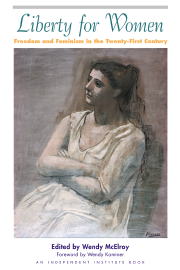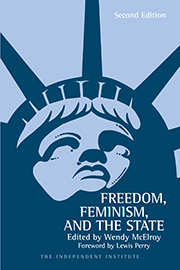Women are, and should be treated as, the equals of men.
For many, that sentiment forms the core of feminist theory and policy. But historically, there has been substantial disagreement within the feminist movement over the meaning of the term equality. Does it mean: equality under existing laws; equality under laws more just than existing ones; a socio-economic equality that may require the law to accord privileges to women such as those embodied in affirmative action; or cultural equality that accords women the same “respect” as men enjoy rather than merely the same legal status?
Throughout most of the nineteenth century, the mainstream of American feminism defined the goal of equality as equal treatment with men under existing laws and equal representation within existing political institutions. For example, the cry of the National American Woman’s Suffrage Association—which, after the passage of the Nineteenth Amendment, became the League of Women Voters—sought to include women in the existing electoral process. As such, the mainstream aimed at reform, not revolution.
More radical feminists of the day protested that the existing laws and institutions—in short, the existing political system—were the source of injustice toward women and it could not be reformed. These feminists saw something fundamentally wrong with society’s laws, which created what many called a “class structure” and what the Austrian economist Ludwig von Mises would have called a “caste” structure. In short, the law created groups of people who were either advantaged or disadvantaged. For these feminists, the system needed to be swept away and replaced before women’s rights could be secured.
The two basic traditions of feminism that fundamentally questioned the political system were socialist feminism, from which contemporary radical feminism draws, and individualist feminism, which is sometimes called libertarian feminism.
Ideological Differences
The differing ideologies of the two traditions were reflected in divergent approaches to equality. To socialist feminists, “equality” was a socio-economic term. Women could be equal only after private property and the economic relationships it encouraged—that is, capitalism—were eliminated. Equality was also a cultural goal that required the sweeping away of what today is called “white male culture.” The nineteenth-century parallel of today’s feminist crusades was the social-purity campaigns, in which socialist feminists prominently figured. Linda Gordon in Woman’s Body, Woman’s Right wrote, “The closer we look, the harder it is to distinguish social-purity groups from feminist ones.” In general, the social-purity campaigns attempted to impose virtue—for example, as embodied in anti-obscenity laws—on society through force of law.
Individualist feminists approached equality in a more strictly legal manner, appealing to natural-law theory. They wished the individual rights of women to be fully acknowledged under laws that protected the person and private property of men and women identically. A term they favored was “self-ownership,” which referred to the moral jurisdiction every human being has over his or her own body and over the products of his or her own labor. This approach not only embraced private property and natural rights, but also involved the refusal to impose virtue, or social purity, on peaceful individuals. Every adult had the right to choose any lifestyle that did not involve aggression against another.
This libertarian attitude did not spring from indifference to social problems, like prostitution. Quite the contrary. Individualist feminists, such as the physician Gertrude B. Kelly, worked with women in New Jersey tenement houses who had turned to prostitution because of poverty. As a result, she became a determined labor activist, demanding the elimination of legal barriers that hindered women in the workplace. Her first article in the radical individualist periodical Liberty dealt with this question in relation to prostitution and suggested that the inability of women to make an adequate living was the cause of that profession. She wrote: “We find all sorts of schemes for making men moral and women religious, but no scheme which proposes to give woman the fruits of her labor.”
Individualist feminists cared deeply about social problems, but they did not believe in governmental solutions. Although many were firmly puritanical in their views and personal conduct, they were even firmer in their commitment to the right of peaceful individuals to choose. If they could not persuade people to be moral, they would not use force to impose a code of morality. Thus, when individualist feminists joined purity campaigns, such as temperance, they advocated voluntary, not legislated, abstinence.
There are other profound ideological differences between socialist and individualist feminism. Indeed, the key concepts of feminism within individualism—such as equality, justice, and class—bear so little relation to the concepts as used by socialists that the definitions often conflict.
Consider the concept of “justice.” The socialist-feminist approach to justice is ends-oriented and defined in terms of a specific social condition. That is, socialist feminism provides a specific blueprint for a just society. Absent patriarchy and capitalism, that society is one in which the socio-economic and cultural equality of women is fully expressed. In other words, justice is the end-state at which society embodies explicit economic, political, and cultural arrangements.
By contrast, the individualist-feminist approach to justice is means-oriented: “justice” refers to a method and not to a specific social or economic arrangement. Whatever arrangements result from the free and peaceful choices of individuals is considered to be just in the legal sense of the word. Whatever is voluntary is “just,” or, at least, it is as close to justice as non-utopia can come. For example, a college that discriminated against women and one that enforced a strict quota favoring them could exist side by side. As long as both were privately funded and no one was forced to participate in either, the arrangement would be just, and the law could not properly interfere.
Discriminating against women might be immoral, as many peaceful actions are, and individualist feminists might well attempt to change the first college’s policy. But they would use education, protest, picketing, boycott, moral persuasion—the whole slate of persuasive strategies. What they could not do as individualist feminists, however, would be to use force to restrict the college’s peaceful choice to not associate with women. Freedom of association requires the right to discriminate.
Socialist feminists were not and are not similarly restricted. If possible, they use the state—even the patriarchal state, the nemesis of women—to enforce their version of a just society. After all, the socialist ideal of justice apparently can be established by force. A specific economic arrangement conceivably can be imposed on society, whereas a voluntary society cannot be created by force.
Yet another fundamental difference between the two traditions resides in the concept of class. According to socialist feminism, sex is the political characteristic that defines a class. Men share not only similar biologies, but also political interests, which are maintained through the institution of patriarchy: male culture and economics, or capitalism. The interests of men are necessarily in conflict with the interests of women.
The primary theme of Catharine MacKinnon’s book Feminism Unmodified is sex as “class.” MacKinnon writes, “The first theme is the analysis that the social relation between the sexes is organized so that men may dominate and women must submit and this relation is sexual-in fact, is sex. Men in particular, if not men alone, sexualize inequality, especially the inequality of the sexes.”
To individualist feminists the political characteristic that determines the class to which an individual belongs is his or her relationship to the state. There are two basic classes: the political class, which acquires wealth or influence through political power; and the economic class, which acquires wealth or influence through voluntary exchange. Each class contains both men and women who, as individuals, are free to change their class affiliations at will.
Since socialist feminism bases classes on biology, they are stable, and men and women are inevitably enemies. In individualist feminism, the classes are fluid, with individual men and women having no necessary conflicts. This one factor alone may explain why the individualist tradition and history contain as many prominent male figures as female ones, and why gender attacks on men tend to be rare.
Thus, individualist feminism is not merely a position on affirmative action or civil liberties. It is a comprehensive, integrated system of beliefs concerning women’s relationship to society. It has a deep, rich history that significantly influenced the status of women in the nineteenth century. It embraces a large body of literature-novels, political tracts, poetry, diaries, speeches-and it involves a distinctive historical interpretation of events such as the Industrial Revolution, which it views as being overwhelmingly beneficial to women.
The richness of this tradition is not surprising when you realize that the very roots of American feminism were profoundly individualistic.
The Individualistic Roots of Feminism
As an organized force, American feminism can be dated from the radical anti-slavery movement, known as abolitionism, that arose in the early 1830s and coalesced around the libertarian William Lloyd Garrison. Although there were many courageous women who advanced the status of women prior to this period, such as Anne Hutchinson and Frances Wright, they spoke out as individuals rather than as part of a self-conscious organization dedicated to women’s rights.
Abolitionism demanded the immediate cessation of slavery on the grounds that every human being was a self-owner and had a moral jurisdiction over his or her own body. Gradually, abolitionist women began to apply the principle of self-ownership not only to the slaves, but also to themselves. Historian Aileen S. Kraditor wrote in her book Up From the Pedestal: “A few women in the abolitionist movement in the 1830s . . . found their religiously inspired work for the slave impeded by prejudices against public activity by women. They and many others began to ponder the parallels between women’s status and the Negro’s status, and to notice that white men usually applied the principles of natural rights and the ideology of individualism only to themselves.”
The abolitionist feminist Abbie Kelley was a case in point when she observed: “We have good cause to be grateful to the slave, for the benefit we have received to ourselves, in working for him. In striving to strike his irons off, we found most surely that we were manacled ourselves.” In 1838, abolitionist Angelina Grimké, in Massachusetts, became the first woman to speak before an American legislative body. Her presentation dramatized how these women mixed the cause of the slave with that of the woman: “Mr. Chairman, it is my privilege to stand before you . . . on behalf of the 20,000 women of Massachusetts whose names are enrolled on petitions . . . [T]hese petitions relate to the great and solemn subject of slavery . . . and because it is a political subject, it has often tauntingly been said that women have nothing to do with it. Are we aliens because we are women? Are we bereft of citizenship because we are mothers, wives, and daughters of a mighty people?”
Unfortunately for American individualism in all its manifestations, the Civil War erupted. If “war is the health of state,” as Randolph Bourne claimed, then it is the death of individualism. At its roots, the individualist tradition is anti-statist, and war inevitably involves an increase in state power that never seems to roll back to prewar levels when peace resumes. The Civil War expanded state powers to include conscription, censorship, suspension of habeas corpus, political imprisonment, and legal-tender laws, and it dramatically increased taxes and tariffs. Individualismwaned.
The Civil War also changed the face of feminism. Before the war the movement had been tending toward political activity, especially toward the demand for suffrage. In attending the 1840 World Anti-Slavery Conference in London, Elizabeth Cady Stanton had been embittered by the dismissive treatment women had received there from the less-enlightened English male radicals. William Lloyd Garrison had been so outraged that he withdrew from the floor to sit instead in the curtained-off section to which the women had been ostracized.
In concert with the Quaker abolitionist Lucretia Mott, Stanton planned the pivotal 1848 Seneca Falls Convention. At this convention, a women’s suffrage resolution was introduced: “Resolved, that it is the duty of the women of this country to secure to themselves their sacred right to the elective franchise.” The resolution met strong resistance from Mott and the old guard of abolitionist feminists who were deeply opposed to using government to solve problems. The suffrage resolution barely passed, although every other one received a unanimous vote.
After the Civil War, feminists again cried out for suffrage. At the behest of the abolitionist men, beside whom they had stood for so many years, feminists shelved their own interests and fought instead for the Fourteenth and Fifteenth Amendments. They hoped for women to be included within the wording. The Fourteenth Amendment linked a state’s basis for representation in the Congress to its protection of the right of male inhabitants to vote-at least, the right of males over 21 who were not untaxed Indians. The Fifteenth Amendment declared that the right to vote could not be abridged because of “race, color, or previous condition of servitude”: no mention was made of sex. Women felt betrayed. In the History of Woman Suffrage Susan B. Anthony wrote, “We repudiated man’s counsels forever.” Perhaps this was the beginning of the emotional backlash against men that some believe now characterizes feminism.
In contrast to mainstream feminism, individualist feminists, who opposed political solutions, tended to express themselves through a variety of other social causes where they functioned as a voice for woman’s rights. The most important was Free Love, a movement that had no connection whatsoever to licentious behavior. It simply declared that all peaceful sexual choices, such as marriage and birth control, were to be left entirely to the adults involved, with no government interference.
The main Free Love periodical for individualist feminists was the provocatively entitled Lucifer the Light Bearer (1883–1907), edited by Moses Harman. In the late 1800s, this periodical was one of the few forums to openly promote birth control as a choice. Its main ally in doing so was The Word (1872–1893), a libertarian periodical edited by Ezra Heywood.
Harman insisted that woman’s self-ownership be fully acknowledged in marriage and other sexual arrangements. Unfortunately, in living his principles, Harman ran counter to the Comstock laws (1873), which prohibited the mailing of obscene-undefined-material. In February 1887, most of the staff of Lucifer was arrested for publishing three letters. One had described the plight of a woman whose husband forced sex on her even though she was recovering from an operation. It is the earliest analysis I have found that identified forced sex within marriage as rape and that called on the law to recognize it as such.
The staff was indicted on 270 counts of obscenity, although only Harman was imprisoned in the end. For decades thereafter, he fought the Comstock laws, his last imprisonment coming in 1906 when he spent a year at hard labor, often breaking rocks for eight hours a day in the Illinois snow. Harman was 75 at the time.
Although it is natural to assume that nineteenth-century feminists applauded Harman’s courage in standing up for women’s rights, this was not the general response. Mainstream feminists often supported statutes that restricted birth control information, considering it to be obscene. One of the pledges of the women candidates in the Kansas election of 1889, for example, was to shut down Harman’s periodical, which issued from their state. In his book The Sex Radicals, historian Hal D. Sears observed, “Conventional feminists bowed before the [Comstock] statute.” The individualist feminists “on libertarian principles, broke this law in order to raise the questions of government censorship and individual self-ownership.”
Thus the earliest voices to call for women’s freedom in sex matters were individualist ones.
I chose a man to exemplify individualist feminism to illustrate and acknowledge the importance of male contributions to the tradition. But Harman illustrates another point as well. Although he is more recognized than most other nineteenth-century individualist feminists, who remain buried in the pages of crumbling periodicals, Harman is rarely identified with that tradition. Part of the reason for this may be a general unfamiliarity with the theory and history of individualist feminism, which leaves historians no accurate ideological context into which such figures can be placed.
Today, the ideology of contemporary feminism seems to be evolving into a dogma with which women cannot disagree without being defined out of the movement. More and more there seems to be only one stand that a card-carrying feminist is allowed to take on issues such as sexual harassment or affirmative action. There has never been a greater need for feminism to remember its roots and to throw open the doors of discussion.










